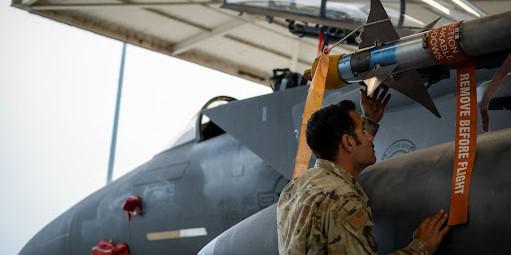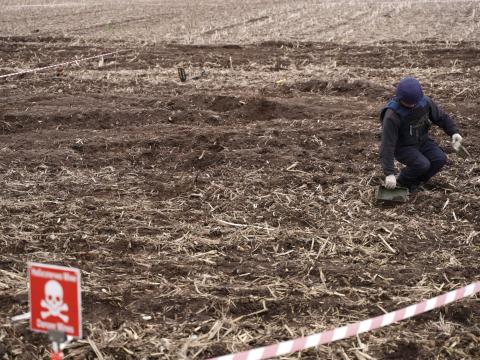U.S. Air Base Defense Is Lacking in Protective Measures
In a near-peer environment, the assumption of homeland safety may not be valid. Dangerous capabilities, such as hypersonics, in development by adversaries, call into risk the safety of U.S. facilities. Allies, like those in the Middle East, who face daily threats already have protective measures, suggests Gen. Mark Kelly, USAF, commander, Air Combat Command, or the ACC. China, who is advancing hypersonics and is considered the greatest threat to America, has its own considerable protections.
The general, who spoke during a Mitchell Institute for Aerospace Studies Aerospace Nation virtual event on October 25, said he would like to see additional defenses for U.S. Air Force bases on the homefront.
“The Air Force’s infrastructure defense efforts are currently focused on directed energy research, development and test evaluation; counter-UAS [unmanned aerial systems]; and investments in cruise missile defense,” Gen. Kelly explained. “But to be an operational force we need air base hardening. We need active and passive defenses; we need Agile Combat Employment. Our Israeli Air Force partners, when I talk to Gen. [Aluf Amikam] Norkin, their Air chief, he wakes up every day under the cover of an ‘iron dome.’ The Finnish Air chief [Maj. Gen. Pasi Jokinen] and that nation operate their Air Force out of a mountain. The Chinese and other adversaries operate under layer, upon layer of air defenses. I'd like all three, but I need at least one.”
As for the ability to face modern threats, the service’s intelligence, surveillance and reconnaissance (ISR) enterprise and electromagnetic spectrum (EMS) capabilities can provide awareness of evolving technological risks from adversaries, Gen. Kelly continued. “If we know where they are at, we can handle them,” the commander said. “In our organic capabilities, on our shooters, we're actually doing a pretty good job of EMS sensing, and the sensing grid that we need out of the fighter force.”
However, the general stressed that the types of modern threats that actually ‘keep him up at night’ include China’s fractional orbital bombardment system, or FOBS.
“The FOBs that we have read about from China that they just tested with one of their hypersonic vehicles, [are] unlike a ballistic trajectory or even a hypersonic glider trajectory,” he warned. “It enters lower earth orbit and then de-orbits to maneuver to a hypersonic terminal state. It should concern us all, every single one of us. The Chinese are serious about displacing our nation in every domain and at every turn.”
As such, relationships with U.S. allies and partners remain part of the general’s daily focus, as he and other leaders work to solidify those relationships. “First and foremost are our allies and partners that we work with both here at the ACC and the other MAJCOMs [major commands] around the globe,” he stated. “For us to project power, we have to have access, basing and overflight. And it's important to know which allies and partners will provide assured access in a time of crisis, which allies and partners will provide high-end interoperability or better, and which allies are truly interchangeable because they're up to a very, very high level of capability. These partnerships are important and stay in the forefront of what we do.
The service’s rapid global mobility efforts also will continue to be a priority. The strategic airlift and air refueling solutions that the service supplies to the military—such as the airlift of 124,000 Afghans and other at-risk people in August—will continue to be a foundational part of the Air Force, especially as it pursues Agile Combat Employment, or ACE. ACE, which is a counter solution to the near-peer environment, is progressing from a niche capability to an everyday style of operating, the general shared. The method of deploying small, agile groups of airmen, aircraft and weapons system to anywhere around the world in short order presents unique logistics challenges, Gen. Kelly noted, but includes issues that they are working to resolve.
“Our mobility warriors are really ready for the task as we train for ACE around the globe,” he shared.
Another key enabler is the command’s ISR, which does need to be expanded to work across the Indo-Pacific region, the U.S. military’s priority theater. The service is continuing to advance its Advanced Battle Management System (ABMS)-related solutions, as command and control, or C2, is a “critical” to a near-peer fight, especially across the Pacific.
“We need our ISR to be persistent, connected and survivable,” Gen. Kelly stated. “Right now we're very persistent. And we're connected through our DCGS [distributed common ground system] for processing, exploitation and dissemination, but our connectivity needs to expand to a real-time node connection in the ABMS and we are working on that hard. The survivability of our ISR enterprise is a focus area, from our fixed wing, RQ-4, U-2 all the way out to our ISR equities in orbit.”
And while the Air Force did not originally design certain aircraft to be flying C2 nodes, in this day and age, the service is deploying some that way to enable ACE or ABMS operations.
“What we see out of all of [our] exercises are the need for innovative solutions to logistics and C2,” Gen. Kelly noted. “We didn't design the HC-130J as an ACE C2 node, but when you have a platform that can move gear, tools, airmen that comes with organic SATCOM [satellite communications] data links and HF comms [high frequency communications], it's really powerful and helps our forces moving in and around theater and sustain the pace of combat ops and complicate adversary targeting, it’s a key topic.”





Comments